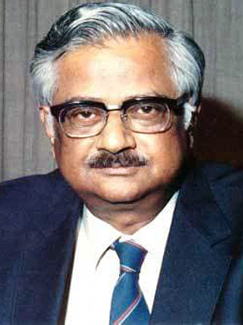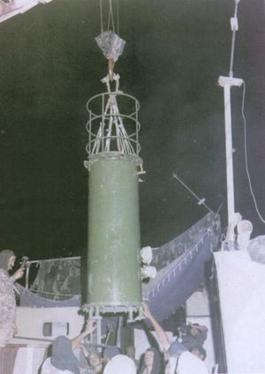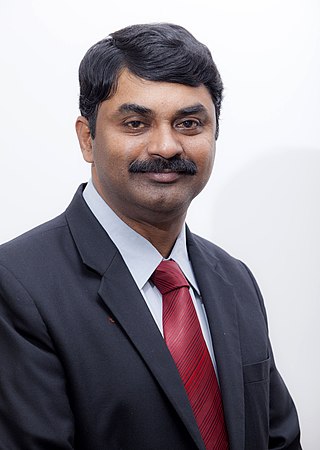Related Research Articles

Operation Smiling Buddha or Operation Happy Krishna was the assigned code name of India's first successful nuclear bomb test on 18 May 1974. The bomb was detonated on the army base Pokhran Test Range (PTR), in Rajasthan, by the Indian Army under the supervision of several key Indian generals.

A directed-energy weapon (DEW) is a ranged weapon that damages its target with highly focused energy without a solid projectile, including lasers, microwaves, particle beams, and sound beams. Potential applications of this technology include weapons that target personnel, missiles, vehicles, and optical devices.

The Defence Research and Development Organisation (DRDO) is the premier agency under the Department of Defence Research and Development in Ministry of Defence of the Government of India, charged with the military's research and development, headquartered in Delhi, India. It was formed in 1958 by the merger of the Technical Development Establishment and the Directorate of Technical Development and Production of the Indian Ordnance Factories with the Defence Science Organisation under the administration of Jawaharlal Nehru. Subsequently, Defence Research & Development Service (DRDS) was constituted in 1979 as a service of Group 'A' Officers / Scientists directly under the administrative control of Ministry of Defence.

Raja Ramanna was an Indian physicist who is best known for his role in India's nuclear program during its early stages.

The Bhabha Atomic Research Centre (BARC) is India's premier nuclear research facility, headquartered in Trombay, Mumbai, Maharashtra, India. It was founded by Homi Jehangir Bhabha as the Atomic Energy Establishment, Trombay (AEET) in January 1954 as a multidisciplinary research program essential for India's nuclear program. It operates under the Department of Atomic Energy (DAE), which is directly overseen by the Prime Minister of India.

The Pokhran-II tests were a series of five nuclear bomb test explosions conducted by India at the Indian Army's Pokhran Test Range in May 1998. It was the second instance of nuclear testing conducted by India; the first test, code-named Smiling Buddha, was conducted in May 1974.

The Department of Atomic Energy (DAE) is an Indian government department with headquarters in Mumbai, Maharashtra, India. DAE was established in 1954 with Jawaharlal Nehru as its first minister and Homi Bhabha as its secretary.

Rajagopala Chidambaram is an Indian Physicist who is known for his integral role in India's nuclear weapons program; he coordinated test preparation for the Pokhran-I (1975) and Pokhran-II (1998).
Electronics Corporation of India Limited is a Public Sector Enterprise under the Department of Atomic Energy, established on 11 April 1967 by A. S. Rao at Hyderabad, under the Prime Ministership of Smt Indira Gandhi, to create a strong indigenous base in electronics. ECIL is a multi-product, multi disciplinary organisation with focus on indigenous nuclear energy, space and defence sectors. ECIL also has a strong presence in indigenous electronic security, communications, networking and e-governance domains. ECIL has committed partnerships with nuclear energy establishments of India, particularly Bhabha Atomic Research Center (BARC), Nuclear Power Corporation of India Limited (NPCIL) and Indira Gandhi Centre for Atomic Research (IGCAR). ECIL also actively supports other strategic sectors such as indigenous Defence, Space, Civil Aviation, Information and Broadcasting, Telecommunications, Insurance, Banking, Police and Para-military Forces, Oil and Gas, Power, Space Education, Health, Agriculture, Steel and Coal.
The Combat Aircraft Systems Development & Integration Centre (CASDIC) is a laboratory of the Indian Defence Research and Development Organisation (DRDO). Located in Bangalore, Karnataka, India, It is one of the two DRDO laboratories involved in the research and development of airborne electronic warfare and mission avionics systems.

The Swathi weapon locating radar is a mobile artillery-locating, phased array radar developed by India. This counter-battery radar is designed to detect and track incoming artillery and rocket fire to determine the point of origin for counter-battery fire.
Electronics and Radar Development Establishment (LRDE) is a laboratory of the Defence Research & Development Organisation (DRDO), India. Located in C.V. Raman Nagar, Bengaluru, Karnataka, its primary function is research and development of radars and related technologies. It was founded by S. P. Chakravarti, the father of Electronics and Telecommunication engineering in India, who also founded DLRL and DRDL.

A particle accelerator is a machine that uses electromagnetic fields to propel charged particles to very high speeds and energies, and to contain them in well-defined beams.
An electromagnetic pulse (EMP), also referred to as a transient electromagnetic disturbance (TED), is a brief burst of electromagnetic energy. The origin of an EMP can be natural or artificial, and can occur as an electromagnetic field, as an electric field, as a magnetic field, or as a conducted electric current. The electromagnetic interference caused by an EMP can disrupt communications and damage electronic equipment. An EMP such as a lightning strike can physically damage objects such as buildings and aircraft. The management of EMP effects is a branch of electromagnetic compatibility (EMC) engineering.

G. Satheesh Reddy is the Scientific Adviser to Raksha Mantri, leading India's indigenous development of defence systems and technologies. He has worked on the development of missiles, fighter aircraft, unmanned aerial defence systems, and radar systems.

The Rudram is a series of air-to-surface ground attack and anti-radiation missiles in development by the Defence Research and Development Organisation of India. It can be launched from a range of altitudes with large standoff distance for destroying enemy surveillance radars, communication stations and bunkers.

On 27 March 2019, India tested an anti-satellite weapon (ASAT) during an operation code named Mission Shakti. The target of the test was a satellite present in a low Earth orbit, which was hit with a kinetic kill vehicle.
The Defence Space Agency (DSA) is an integrated tri-services agency of the Indian Armed Forces. Headquartered in Bengaluru, Karnataka, India. The agency is tasked with operating the space-warfare and Satellite Intelligence assets of India. The DSA draws personnel from all three branches of the Armed Forces.

Akash - New generation abbreviated as Akash-NG is a mid-ranged mobile surface-to-air missile defense system developed by the Defence Research and Development Organisation (DRDO) and produced by Bharat Dynamics Limited (BDL) and Bharat Electronics (BEL).
This article consists of projects of the Defence Research and Development Organisation.
References
- 1 2 "Development of High Power Pulsed Electron Accelerators". barc.gov.in.
- ↑ Obering III, Henry ("Trey") (2020-01-01). "Directed Energy Weapons Are Real...And Disruptive" (PDF). PRISM. National Defense University Press.
- ↑ "India to test beam weapon". Competition Science Journal. October 1999 (20). Mahendra Jain: 980–981. 1999.
- ↑ BARC Director's speech on October 29 2004 celebrating Dr. Homi Bhabha's 95th Birth Anniversary